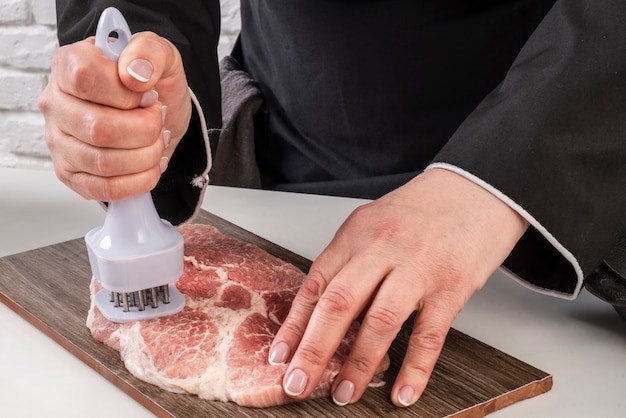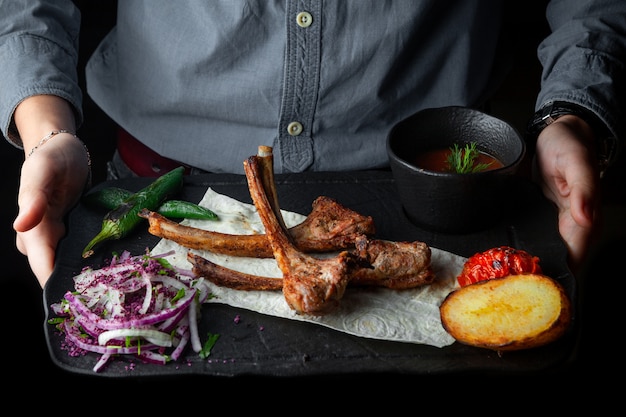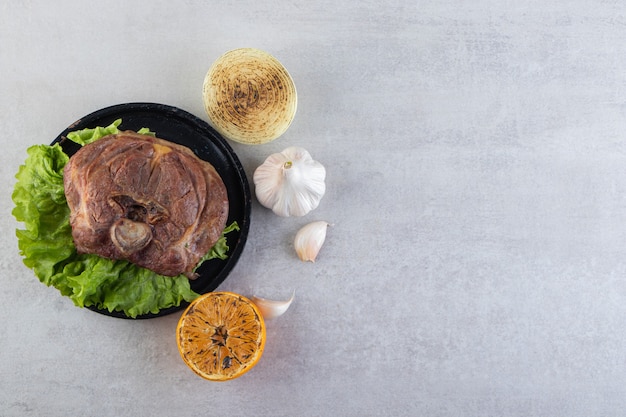Let's be honest, pork loin can be a bit of a mystery. It’s a cut of meat that can be a little tricky to master, but when you get it right, it’s an absolute triumph. I’ve been cooking pork loin for ages, and I’ve learned a thing or two along the way. So, I’m going to share my secrets with you, so you can cook up a storm in the kitchen and impress everyone with your culinary skills.
(Part 1) Choosing the perfect pork loin
The Cut: A Tale of Two Loins

First things first, we need to talk about the cut. There are two main types of pork loin: the loin roast and the tenderloin. The loin roast is the bigger brother, with the bone still attached. It's a great option for a big family gathering, and usually, it’s the more budget-friendly choice. The tenderloin, on the other hand, is boneless and much smaller, often called the “filet mignon” of pork. It’s incredibly tender and juicy and perfect for smaller gatherings or if you want to create a truly impressive meal.
Knowing Your Loin
When you're at the butcher counter picking out your pork loin, there are a few things to keep in mind. First, you want to make sure it has a good amount of fat marbling. This fat is key – it's going to add flavor and keep the meat wonderfully juicy during cooking. You also want to check the color. A good pork loin should be a light pink, with no discolouration. If it smells ammonia-like, steer clear! That's a sure sign it’s not fresh.
Size Matters

Now, how much pork loin you need depends on how many hungry mouths you're feeding. A general rule of thumb is about half a pound of pork loin per person. So, for four people, you'll need about two pounds. But remember, it’s always a good idea to buy a little extra, just in case!
The Difference Between Roasting and Cooking

This is a subtle but important distinction that often gets overlooked: "roasting" is a type of cooking, but not all cooking is roasting. Roasting implies cooking in an oven, usually at a high temperature, using dry heat. But you can cook a pork loin in other ways, like pan-frying, grilling, or even slow cooking, and these wouldn’t be considered roasting. So, when you’re choosing your loin, keep in mind what kind of cooking technique you’re going to use.
(Part 2) Prepping the Pork Loin
The Importance of Trimming
Once you’ve got your pork loin home, it’s time to get it prepped for cooking. The first step is to trim any excess fat. You don’t need to remove all of it, just the excess. This will help prevent the pork loin from becoming greasy during cooking. Use a sharp knife or even kitchen shears for this task.
The Salt-It-Early Method
Now, here’s a little trick I’ve learned over the years: salt your pork loin early. This process is called “dry brining.” And I’m not talking about just a pinch or two, either. We’re talking about generously salting the pork loin and then letting it sit in the fridge uncovered for several hours, or even overnight. This technique draws out some of the moisture, which is then reabsorbed, resulting in a more tender and flavourful pork loin. It might sound counterintuitive to dry out the meat, but trust me on this one!
Dry Brining: The Nitty-Gritty
For dry brining, aim for about 1 tablespoon of salt per pound of pork loin. You can add other spices like black pepper, garlic powder, onion powder, or even paprika to your dry brine for additional flavor. Just make sure you’re using kosher salt, as it’s a coarser salt than table salt, meaning you’ll be able to get a more even coating on the pork loin.
The Seasoning Game
Now that we’ve got the dry brining sorted, it’s time to talk about seasoning. This is where you can really unleash your creativity. I like to use a simple combination of salt, pepper, and garlic powder, but you can add all sorts of things, like herbs, spices, or even rubs. Just make sure you season the pork loin generously, so the flavour really shines through.
Rub Your Way to Flavor
Speaking of rubs, I’m a big fan of making my own spice blends. You can find pre-made rubs at the supermarket, but they can be expensive. Making your own is so much cheaper, and it’s a lot of fun! I have a basic recipe that I use for pork loin:
1 tablespoon paprika
1 tablespoon garlic powder
1 tablespoon onion powder
1 teaspoon dried thyme
1 teaspoon dried oregano
1 teaspoon black pepper
1 teaspoon salt
Just combine all the ingredients in a small bowl and rub it all over the pork loin. It’s that simple!
(Part 3) Cooking the Pork Loin
oven roasting: A Classic
Right, the moment we’ve all been waiting for: cooking the pork loin. This is where things get exciting. Let’s start with the classic method: oven roasting. It’s simple, foolproof, and delivers a delicious result.
The oven method
Preheat your oven to 350°F (175°C). Place your seasoned pork loin in a roasting pan, fat-side up. You can add some vegetables to the pan with the pork loin, such as potatoes, carrots, or onions. These vegetables will soak up some of the juices from the pork loin as it cooks, creating a delicious and flavorful side dish.
The Temperature Game
Now, here’s the crucial part. We need to talk about the internal temperature. You want to cook the pork loin to an internal temperature of 145°F (63°C) for medium-rare. This ensures the pork loin is cooked through and safe to eat, without drying it out. You can use a meat thermometer to check the temperature. Insert the thermometer into the thickest part of the pork loin, making sure it doesn't touch bone.
Pan-Frying for a Crispy Crust
For a delicious crispy crust, you can try pan-frying your pork loin. This is a great option for smaller cuts of meat. You’ll need a heavy-bottomed frying pan, a good amount of oil, and a high heat.
The Frying Technique
Heat the oil in the frying pan over medium-high heat. Season your pork loin generously with salt, pepper, and any other spices you like. Once the oil is hot, add the pork loin to the frying pan. You want to hear a gentle sizzle when the pork loin hits the oil. Let it cook for about 4-5 minutes per side, or until it’s golden brown and crispy.
The Rest is Key
After you’ve seared the pork loin, you can move it to a preheated oven to finish cooking. This will help ensure the pork loin is cooked through without drying it out.
(Part 4) Finishing Touches and Serving
Resting is a Must
Now, here’s another important tip: let the pork loin rest for 10-15 minutes before carving it. This allows the juices to redistribute, resulting in a more tender and flavorful pork loin. Cover it loosely with foil while it rests.
Carving: It's All About Technique
After the resting period, it’s time to carve the pork loin. You can use a sharp carving knife or a meat cleaver. If you’re using a carving knife, make sure you cut against the grain of the meat, which will make the slices more tender. If you’re using a meat cleaver, chop the pork loin into bite-sized pieces.
Serving Ideas
Now, for the exciting part: serving the pork loin! You can serve it with your favorite sides, such as roasted vegetables, mashed potatoes, or a green salad. You can also make a delicious gravy with the pan juices, or a simple sauce using mustard, honey, and lemon juice.
(Part 5) Tips and Tricks for Success
Don't Be Afraid of the Fat
Remember that fat is your friend. Don’t trim off all the fat, it’s what will keep the pork loin juicy and flavorful.
Avoid Overcrowding
Don’t overcrowd your pan when roasting or pan-frying the pork loin. It will steam, rather than brown. Give it some space!
Use a Meat Thermometer
Investing in a meat thermometer is a good idea. It’s the only way to be absolutely sure your pork loin is cooked to the right temperature.
Don't Overcook
overcooked pork loin is dry and tough. You want it to be cooked through, but still juicy and tender.
Get Creative with Flavours
Don’t be afraid to experiment with different seasonings and marinades. You can find so many delicious combinations online.
(Part 6) FAQs: Answers to Your Questions
1. What if the Pork Loin is Too Dry?
If your pork loin is too dry, it’s likely because you’ve overcooked it. You can add some moisture back in by making a gravy with the pan juices or by adding some broth to the pan while you’re roasting it.
2. Can I Cook a Pork Loin from Frozen?
While it’s not ideal, you can cook a pork loin from frozen. Just make sure you cook it at a lower temperature and for a longer period of time.
3. What Should I Do With leftover pork loin?
Leftover pork loin can be used in sandwiches, salads, or pasta dishes. It’s also great for breakfast, chopped up and added to scrambled eggs.
4. What Temperature Should I Cook My Pork Loin to?
The safe internal temperature for pork loin is 145°F (63°C). This will ensure the pork loin is cooked through and safe to eat.
5. Can I Grill a Pork Loin?
Absolutely! Grilling is a great way to cook a pork loin. Just make sure you preheat your grill and cook it over medium heat.
(Part 7) pork loin variations
The Sweet and Savoury Duo
Here’s a classic that always works: a honey-mustard glazed pork loin. It’s a simple combination of honey, mustard, and a touch of garlic and onion powder.
Glazing Tips
The key to a good glaze is to brush it on the pork loin during the last 15 minutes of cooking. This will help the glaze caramelize and create a beautiful crispy crust.
Mediterranean Flavours
A little Mediterranean flair can really elevate the pork loin. Think lemon, garlic, oregano, and olive oil.
Marination Magic
For a Mediterranean pork loin, try marinating it for a few hours before cooking. This will help infuse the flavours into the meat.
The Spicy Option
Love a bit of spice? You can add some chilli flakes or cayenne pepper to your pork loin rub.
Cautious Spice
Start with a small amount of spice and add more to taste, as it can be easy to overdo it!
(Part 8) Mastering the Art of Pork Loin
Patience is a Virtue
Like with many things in life, cooking a great pork loin takes a little patience. Don’t rush the process, allow the pork loin to cook slowly and evenly.
Experiment and Have Fun!
Don’t be afraid to experiment with different flavours and techniques. The best way to learn is to try new things and see what you like best.
Embrace Mistakes
Everyone makes mistakes in the kitchen. Don’t let a few missteps get you down. Learn from your mistakes and keep practicing.
Enjoy the Process
Cooking should be enjoyable. Take your time, relax, and have fun with it!
So there you have it, my ultimate guide to perfectly cooked pork loin. I hope you found it helpful. Now, go forth and cook up a storm!
(Part 9) Pork Loin Variations: A Deeper Dive
The Classic Herb Roast
This simple yet elegant approach involves using fresh herbs like rosemary, thyme, and sage, along with a little garlic and onion. It's a wonderful way to showcase the natural flavors of the pork loin.
Tips for Herb Roasting
You can use fresh or dried herbs, but fresh herbs will give a more vibrant flavor.
If using dried herbs, crush them slightly to release their aromas.
Tie the herb sprigs together with kitchen twine and place them under the pork loin in the roasting pan.
You can also create a herb paste by blending the herbs with olive oil and garlic, then spread this paste over the pork loin.
Asian-Inspired Pork Loin
This variation brings a touch of Asian flavor with soy sauce, ginger, garlic, and a bit of honey. You can also add ingredients like sesame oil, chili flakes, and star anise.
Asian-Inspired Tips
Marinate the pork loin in the sauce for at least an hour, or even overnight for a more intense flavor.
During the final stages of roasting, brush the pork loin with a glaze made from the marinade for a beautiful sheen and extra flavor.
Serve the pork loin with rice, stir-fried vegetables, and a dipping sauce for a complete Asian-inspired meal.
The "Apple-licious" Pork Loin
This combination of pork and apples is a true classic. The sweetness of the apple pairs perfectly with the savory pork, creating a truly delicious dish.
Apple-licious Tips
Use tart apples like Granny Smith or Braeburn for the best flavor contrast.
Slice the apples thinly and place them around the pork loin in the roasting pan.
You can also add a little apple cider or apple juice to the roasting pan for extra flavor and moisture.
Finish the dish with a drizzle of maple syrup or a dollop of apple butter.
(Part 10) Going Beyond the Basics: Pork Loin Adventures
Pork Loin in the slow cooker
For a super tender and flavorful pork loin, try slow cooking it. This method is perfect for a busy weeknight as you can set it and forget it!
slow cooker tips
Use a slow cooker with a "low" setting.
Season the pork loin generously with salt, pepper, and any other spices you like.
Add some liquid to the slow cooker, such as broth, apple juice, or wine.
Cook for 6-8 hours, or until the pork loin is fork-tender.
Pork Loin on the Grill
Grilling pork loin is a great way to add a smoky flavor. It’s a perfect option for summer cookouts.
grilling tips
Preheat the grill to medium heat.
Season the pork loin generously with salt, pepper, and any other spices you like.
Grill for about 10-15 minutes per side, or until the pork loin is cooked through.
You can add wood chips to the grill to enhance the smoky flavor.
(Part 11) The Pork Loin: A Culinary Canvas
The pork loin is incredibly versatile and adaptable. Whether you’re a seasoned cook or just starting out, it’s a cut of meat that can be tailored to your preferences and culinary creativity. I encourage you to explore different flavor combinations, cooking techniques, and serving styles to find what works best for you.
Now go forth and experiment! The culinary world is your oyster (or rather, your pork loin).
Everyone is watching

How to Cook Frozen Lobster Tails Perfectly: A Step-by-Step Guide
RecipesLobster. Just the word conjures up images of lavish meals, special occasions, and a taste of luxury. But let's...

Pigs in a Blanket Cooking Time: How Long to Bake for Perfect Results
RecipesAh, pigs in a blanket. Just the name conjures up images of those delightful little parcels of crispy pastry en...

Pork Fillet Cooking Time: How Long to Cook It Perfectly
RecipesPork fillet, or tenderloin as it's sometimes called, is a real favourite in our house. It's so versatile, and...

The Ultimate Guide to Cooking Delicious Frankfurters
RecipesLet's face it, we all love a good frankfurter. It's a classic, simple, and always satisfying. But let's be rea...

Wolf Meat Recipes: A Guide to Cooking Wild Game
RecipesLet's be honest, you don't see wolf meat at your local butcher shop every day. It's a bit of a wild card, but ...
